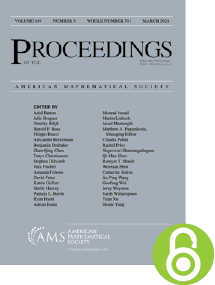A predator-prey system with Holling-type functional response
HTML articles powered by AMS MathViewer
- by Nabil Beroual and Tewfik Sari PDF
- Proc. Amer. Math. Soc. 148 (2020), 5127-5140 Request permission
Abstract:
We consider the Gause-type predator-prey system with a large class of growth and response functions, in the case where the response function is not smooth at the origin. We discuss the conditions under which this system has exactly one stable limit cycle or has a positive stable equilibrium point and we describe the basin of attraction of the stable limit cycle and the stable equilibrium point, respectively. Our results correct previous results of the existing literature obtained for the Holling response function $x^p/(a+x^p)$, in the case where $0<p<1$.References
- R. P. Agarwal and V. Lakshmikantham, Uniqueness and nonuniqueness criteria for ordinary differential equations, Series in Real Analysis, vol. 6, World Scientific Publishing Co., Inc., River Edge, NJ, 1993. MR 1336820, DOI 10.1142/1988
- Nabil Beroual and Ahmed Bendjeddou, On a predator–prey system with Holling functional response: $x^p/(a+x^p)$, Nat. Acad. Sci. Lett. 39 (2016), no. 1, 43–46. MR 3451609, DOI 10.1007/s40009-015-0400-6
- J. Dieudonné, Foundations of modern analysis, Pure and Applied Mathematics, Vol. X, Academic Press, New York-London, 1960. MR 0120319
- Herbert I. Freedman, Deterministic mathematical models in population ecology, Monographs and Textbooks in Pure and Applied Mathematics, vol. 57, Marcel Dekker, Inc., New York, 1980. MR 586941
- C. S. Holling, The functional response of predators to prey density and its role in mimicry and population regulation, Mem. Ent. Soc. Can., 45 (1965), pp. 5–60.
- Xun Cheng Huang and Stephen J. Merrill, Conditions for uniqueness of limit cycles in general predator-prey systems, Math. Biosci. 96 (1989), no. 1, 47–60. MR 1013301, DOI 10.1016/0025-5564(89)90082-5
- Y. Kuang, Global stability of Gause-type predator-prey systems, J. Math. Biol. 28 (1990), no. 4, 463–474. MR 1057049, DOI 10.1007/BF00178329
- Yang Kuang and H. I. Freedman, Uniqueness of limit cycles in Gause-type models of predator-prey systems, Math. Biosci. 88 (1988), no. 1, 67–84. MR 930003, DOI 10.1016/0025-5564(88)90049-1
- Yaping Liu, Geometric criteria for the nonexistence of cycles in Gause-type predator-prey systems, Proc. Amer. Math. Soc. 133 (2005), no. 12, 3619–3626. MR 2163598, DOI 10.1090/S0002-9939-05-08026-3
- Hal L. Smith and Paul Waltman, The theory of the chemostat, Cambridge Studies in Mathematical Biology, vol. 13, Cambridge University Press, Cambridge, 1995. Dynamics of microbial competition. MR 1315301, DOI 10.1017/CBO9780511530043
- Jitsuro Sugie, Uniqueness of limit cycles in a predator-prey system with Holling-type functional response, Quart. Appl. Math. 58 (2000), no. 3, 577–590. MR 1770656, DOI 10.1090/qam/1770656
- Jitsuro Sugie and Masaki Katayama, Global asymptotic stability of a predator-prey system of Holling type, Nonlinear Anal. 38 (1999), no. 1, Ser. B: Real World Appl., 105–121. MR 1693000, DOI 10.1016/S0362-546X(99)00099-1
- Jitsuro Sugie, Rie Kohno, and Rinko Miyazaki, On a predator-prey system of Holling type, Proc. Amer. Math. Soc. 125 (1997), no. 7, 2041–2050. MR 1396998, DOI 10.1090/S0002-9939-97-03901-4
- J. Sugie, K. Miyamoto, and K. Morino, Absence of limit cycles of a predator-prey system with a sigmoid functional response, Appl. Math. Lett. 9 (1996), no. 4, 85–90. MR 1415457, DOI 10.1016/0893-9659(96)00056-0
- Dongmei Xiao and Zhifeng Zhang, On the uniqueness and nonexistence of limit cycles for predator-prey systems, Nonlinearity 16 (2003), no. 3, 1185–1201. MR 1975802, DOI 10.1088/0951-7715/16/3/321
Additional Information
- Nabil Beroual
- Affiliation: Department of Mathematics, University Ferhat Abbes, Sétif, Algeria
- MR Author ID: 756169
- Email: n.beroual@univ-setif.dz
- Tewfik Sari
- Affiliation: ITAP, Univ Montpellier, INRAE, Institut Agro, Montpellier, France
- MR Author ID: 154625
- ORCID: 0000-0002-6274-7826
- Email: tewfik.sari@inrae.fr
- Received by editor(s): January 10, 2019
- Received by editor(s) in revised form: November 4, 2019
- Published electronically: September 11, 2020
- Additional Notes: The authors thank the CNRS-PICS project CODYSYS 278552 and the Euro-Mediterranean research network TREASURE http://www.inra.fr/treasure for financial support.
- Communicated by: Wenxian Shen
- © Copyright 2020 American Mathematical Society
- Journal: Proc. Amer. Math. Soc. 148 (2020), 5127-5140
- MSC (2010): Primary 34A12, 34C05, 34D23; Secondary 70K05, 92D25
- DOI: https://doi.org/10.1090/proc/15166
- MathSciNet review: 4163827


